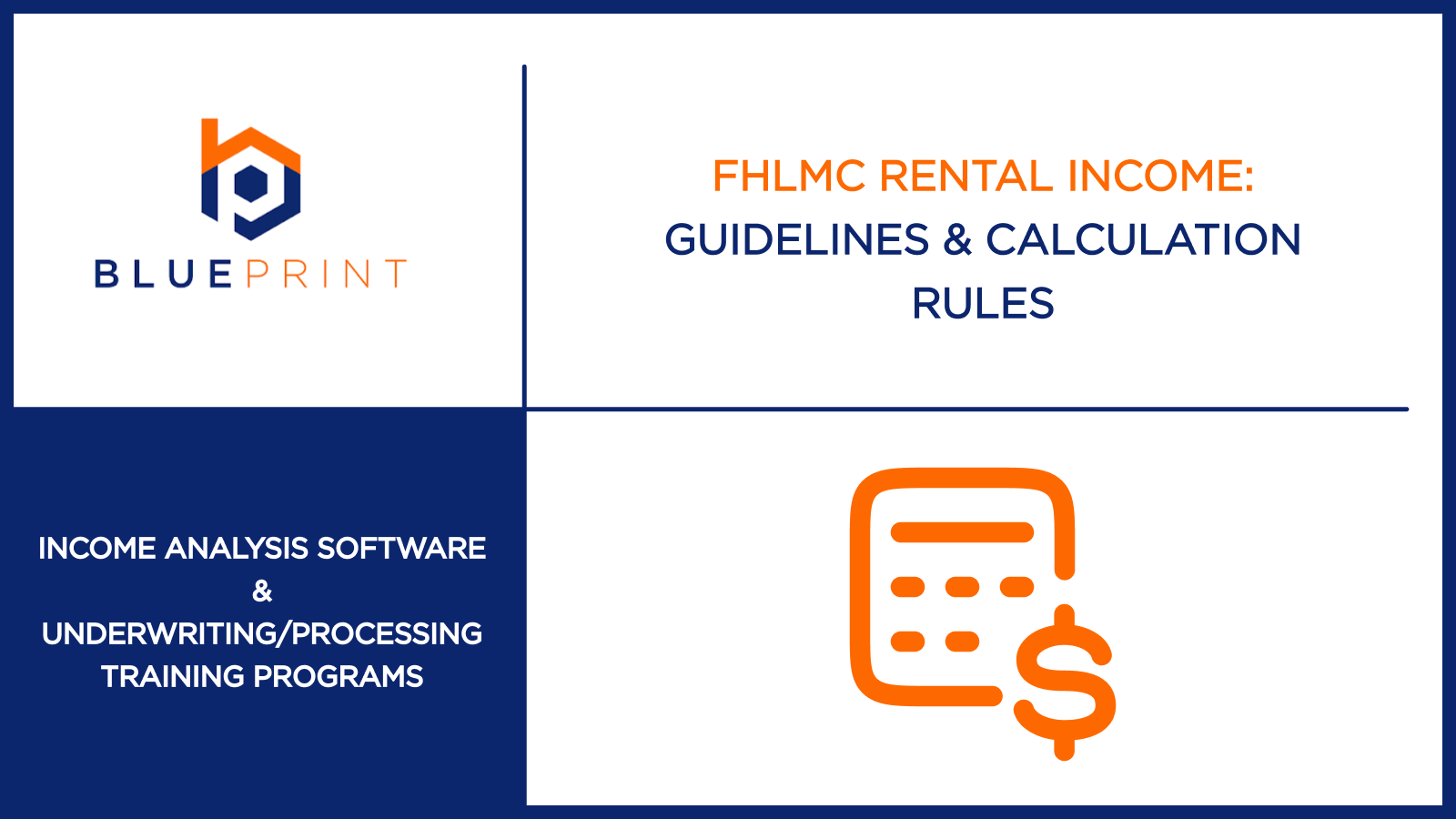Rental income plays a crucial role in the mortgage application process, especially when borrowers rely on income from investment properties or rental units to qualify. For lenders, Freddie Mac (Federal Home Loan Mortgage Corporation) provides a comprehensive set of guidelines that dictate how rental income must be verified and calculated in order to ensure underwriting decisions are compliant and consistent.
In this article, we will discuss the key requirements, acceptable income sources, calculation methods, necessary documentation, and common pitfalls associated with Freddie Mac’s rental income assessment, and also explore how automation tools like IncomeXpert can assist lenders in managing rental income analysis efficiently and maintaining compliance with FHLMC standards.
Main takeaways from this article:
- Freddie Mac has specific guidelines for how lenders must calculate and verify rental income for mortgage applicants, covering various sources like tax returns and lease agreements.
- Eligibility for considering rental income involves factors such as the history of receipt, proof of property ownership, and the property’s occupancy status, each requiring specific documentation.
- Calculating rental income differs based on the source, often involving adjustments like the 75% rule for lease-based income and careful consideration of expenses from tax returns.
- Tools like IncomeXpert can automate the rental income analysis process, aiding in compliance with Freddie Mac guidelines and reducing common underwriting errors.
Why FHLMC rental income rules matter

Rental income, when properly verified and calculated, can be a valuable component of a borrower’s qualifying income. Therefore, Freddie Mac’s rental income guidelines provide a standardized framework for assessing a borrower’s capacity to manage mortgage payments, especially when rental income plays a part in their overall financial profile.
These rules promote responsible lending practices and reduce the risk of loan default due to overstated or unsustainable income. Lenders who comply with FHLMC’s rules are in a better position to sell or guarantee mortgages, which helps them maintain liquidity in the mortgage market.
Acceptable rental income sources under Freddie Mac
Freddie Mac recognizes several sources of rental income as acceptable for mortgage qualification:
- Schedule E income: For properties the borrower has owned and rented for at least one year, income and expenses reported on Schedule E (Supplemental Income and Loss) of the borrower’s federal income tax returns are a primary source for assessing rental income.
- Lease-based income: When dealing with newly acquired properties or properties not yet reflected on tax returns, lenders can use signed lease agreements to determine potential rental income. This method relies on tenants’ contractual obligations.
- Multi-unit primary residences: If a borrower owns a multi-unit property (e.g., duplex, triplex, fourplex) and occupies one of the units as their primary residence, the net rental income from the other units can be considered.
- Investment properties: Rental income from investment properties owned for at least one year, or recently acquired properties that meet certain criteria, can be included. The property must be held for investment purposes, and documentation must support the income’s stability.
Eligibility requirements for rental income
Not all rental income qualifies for consideration in a mortgage application under Freddie Mac guidelines. Certain criteria must be met to ensure the income is stable and likely to continue, such as:
History of receipt
Freddie Mac requires evidence that rental income has been received consistently over a long period. Generally, at least two years of documented receipt is preferred, demonstrating income stability. This history helps lenders determine whether the income is sustainable and can be relied upon for future qualification purposes. Some rental income may be considered with less than two years of history, if it’s documented and deemed stable by the lender.
Rental property ownership verification
Rental property ownership must be verified to ensure eligibility for rental income. This is typically done through the credit report, which shows the presence of a mortgage, or by using tools like DataVerify or other fraud detection tools. If the property is new or has been recently transferred, evidence of ownership can be provided through the property deed or title work.
Occupancy classification
The occupancy status of the property influences whether rental income can be included. For example, primary residences with rented units can qualify under certain conditions, while income from properties classified as investment or second homes may have different criteria. Clear classification ensures accurate income assessment.
Required documentation for FHLMC rental income

The documentation required to verify rental income varies depending on the source of the income and the property’s history.
For existing rental properties
Lenders should obtain tax returns for the prior calendar year and check Schedule E, along with current rent statements, lease agreements, and proof of property ownership. These documents verify the rental income received and the property’s ownership status, establishing a reliable basis for income calculation.
For new properties or newly rented units
A complete and signed lease agreement is essential for properties not yet reflected on tax returns or for newly rented units in an existing property. Signed lease agreements must typically be for 12 months to be considered stable and acceptable. This document should outline the rental amount, lease term, and other relevant conditions. If available, lenders may also request additional documentation, such as security deposit receipts or rent payment history.
How to calculate FHLMC rental income

The method for calculating net rental income depends on the documentation used. Freddie Mac emphasizes determining a stable and sustainable income figure.
1. From tax returns (Schedule E)
When using Schedule E, lenders typically take the gross rental income reported and subtract total expenses. However, certain non-cash expenses, such as depreciation and depletion, may be added to the net income. Freddie Mac requires that this adjusted net income be annualized and that PITIA be subtracted from it before it is added to the borrower’s qualifying income.
It is crucial to carefully analyze Schedule E and understand which expenses are deductible for tax purposes but may not represent actual cash outlays affecting the borrower’s ability to service the mortgage.
2. From leases
If relying on a lease agreement, lenders generally use 75% of the gross monthly rent to account for potential vacancies and maintenance expenses. This 25% reduction is a standard adjustment under Freddie Mac guidelines.
For example, if the monthly rent is $1,000, the calculated rental income would be $1,000 x 0.75 = $750. This amount contributes to the borrower’s annualized income assessment.
Common errors in rental income underwriting

Some mistakes can occur during the underwriting process when evaluating rental income. These mistakes commonly stem from:
Using gross rent without applying the 75% adjustment
Freddie Mac generally allows lenders to use 75% of gross rental income to account for vacancy and maintenance costs. A frequent error is using the full gross rent from a lease without applying the standard 25% reduction, which may result in overstating the income and misrepresenting the borrower’s actual earning capacity.
Not subtracting PITIA from net income
For investment properties already securing a mortgage, lenders must consider the Property Taxes, Insurance, and Association dues (PITIA) associated with that property when calculating the net rental income available to the borrower. Failing to account for these ongoing expenses can lead to an inflated income assessment.
Forgetting to add back depreciation or interest from Schedule E
When using Schedule E, some lenders mistakenly fail to add back non-cash expenses like depreciation or mortgage interest that are tax-deductible but do not represent actual cash outflows affecting the borrower’s repayment ability.
Using inconsistent documentation periods
Freddie Mac requires a uniform period for reviewing income, such as a full calendar year, for the rental income analysis. Inconsistent documentation periods could lead to discrepancies and affect the lender’s ability to assess income accuracy and stability.
Note: Lenders should be aware of any minimum lease term requirements to ensure the income is likely to continue.
Accepting rental income from unapproved sources
Relying on income from sources not explicitly approved by Freddie Mac guidelines, such as undocumented cash payments or short-term rental income without a sufficient history, can result in non-compliance.
How IncomeXpert supports rental income analysis
Accurately analyzing rental income involves gathering, organizing, and verifying multiple documents while adhering to strict guidelines. IncomeXpert reduces manual effort and errors as it:
- Automates and organizes documentation: IncomeXpert can automatically collect, organize, and categorize the necessary documentation, such as tax returns and lease agreements, reducing the manual effort involved in gathering and managing these files.
- Supports compliance and audit readiness: The tool is built with up-to-date agency guidelines, including Freddie Mac’s requirements, embedded within its workflow. This helps ensure the analysis aligns with current regulations, facilitating compliance and simplifying audits.
- Ensures compliance with agency guidelines: IncomeXpert’s automated calculations and checks help lenders consistently apply Freddie Mac’s rules, such as the 75% gross rent adjustment and the consideration of PITIA, minimizing the risk of errors and non-compliant income assessments.
- Reduces manual errors in income assessment: By automating calculations and data extraction, IncomeXpert significantly reduces the potential for manual errors that can occur when underwriters manually review documents and perform calculations.
Get rental income right with IncomeXpert
Complying with Freddie Mac’s rental income requirements demands careful attention to detail in documentation and calculation. Understanding the acceptable income sources, eligibility criteria, and potential pitfalls is essential for accurate underwriting and risk management.
IncomeXpert stands out as the go-to solution for a streamlined approach to rental income analysis that supports adherence to agency standards and reduces manual errors. Its automation capabilities and focus on compliance offer mortgage professionals a more reliable and effective way to assess this crucial component of a borrower’s financial profile.
Don’t leave rental income calculations to chance—trust our tool to deliver compliant and efficient underwriting support! Request a demo now!

